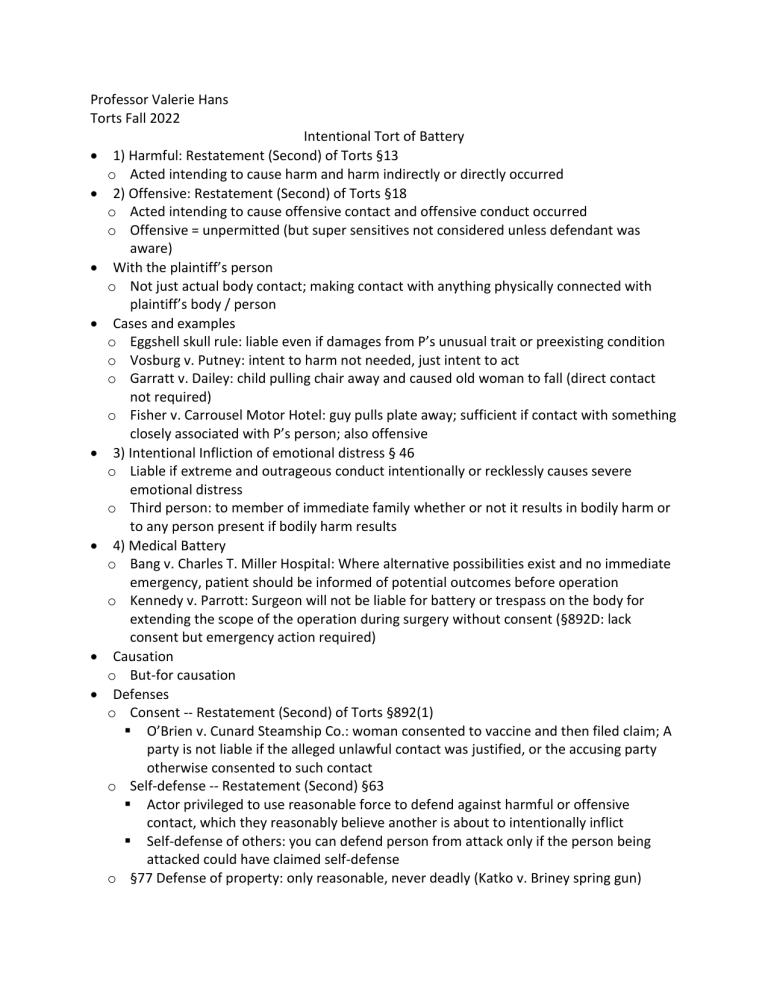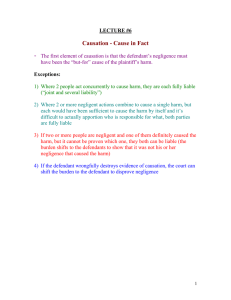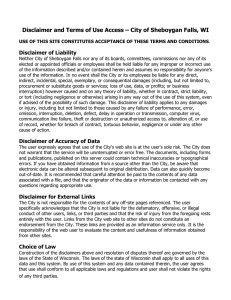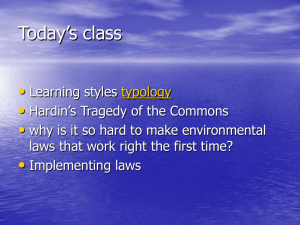
Professor Valerie Hans Torts Fall 2022 Intentional Tort of Battery 1) Harmful: Restatement (Second) of Torts §13 o Acted intending to cause harm and harm indirectly or directly occurred 2) Offensive: Restatement (Second) of Torts §18 o Acted intending to cause offensive contact and offensive conduct occurred o Offensive = unpermitted (but super sensitives not considered unless defendant was aware) With the plaintiff’s person o Not just actual body contact; making contact with anything physically connected with plaintiff’s body / person Cases and examples o Eggshell skull rule: liable even if damages from P’s unusual trait or preexisting condition o Vosburg v. Putney: intent to harm not needed, just intent to act o Garratt v. Dailey: child pulling chair away and caused old woman to fall (direct contact not required) o Fisher v. Carrousel Motor Hotel: guy pulls plate away; sufficient if contact with something closely associated with P’s person; also offensive 3) Intentional Infliction of emotional distress § 46 o Liable if extreme and outrageous conduct intentionally or recklessly causes severe emotional distress o Third person: to member of immediate family whether or not it results in bodily harm or to any person present if bodily harm results 4) Medical Battery o Bang v. Charles T. Miller Hospital: Where alternative possibilities exist and no immediate emergency, patient should be informed of potential outcomes before operation o Kennedy v. Parrott: Surgeon will not be liable for battery or trespass on the body for extending the scope of the operation during surgery without consent (§892D: lack consent but emergency action required) Causation o But-for causation Defenses o Consent -- Restatement (Second) of Torts §892(1) O’Brien v. Cunard Steamship Co.: woman consented to vaccine and then filed claim; A party is not liable if the alleged unlawful contact was justified, or the accusing party otherwise consented to such contact o Self-defense -- Restatement (Second) §63 Actor privileged to use reasonable force to defend against harmful or offensive contact, which they reasonably believe another is about to intentionally inflict Self-defense of others: you can defend person from attack only if the person being attacked could have claimed self-defense o §77 Defense of property: only reasonable, never deadly (Katko v. Briney spring gun) o §263 Defense of necessity: only against property torts; destroy homes to stop fire §197: Necessity-based privilege to enter another’s land to avoid serious harm to person, land, or chattels; entrant obligated to pay for whatever harm caused §263 May damage another’s chattels to avoid serious harm Ploof v. Putnam: Entry on another’s land may be justified by necessity (man docked his boat and servant untied it) Vincent v. Lake Erie Transportation Co.: A party who damages the property of another while acting out of private necessity must compensate the property owner for the resulting damage (damage to dock when boat anchored to it to avoid storm) Both Battery and Negligence Alternative liability / causation o If unable to prove but-for, burden of proof shifts to defendants (Ds must prove which one did it) o Summers v. Tice: (quail hunting) two independent tortfeasors may be held jointly liable if it is impossible to tell which one caused the plaintiff's injuries, and the burden of proof will shift to the defendants to either absolve themselves of liability or apportion the damages between them o Ybarra v. Spangard: doctors and nurses all liable Joint and several liability o When: D’s acted together to cause the harm, or D’s acted independently but caused indivisible harm, or it is impossible to allocate harm to either D’s conduct o Joint: Ds can be joined in single lawsuit o Several: Ds each liable for P’s damages, but P only entitled to proportionate recovery o R3: liability for damages in proportion to share of responsibility Market share liability o P finds D with substantial share of market; burden shifts to D’s (escape liability if you can prove it wasn’t you, otherwise liable for damages corresponding to percentage share of product’s market) o Sindell v. Abbott Labs: Company that made drug (DES) that pregnant women took but gave their babies cancer Concurrent and Successive Causation o When two or more causal agents would, independent of each other, have caused P’s harm o Dillon v. Twin State Gas & Electric Co.: Boy playing on bridge would have fallen to his death but grabbed a wire and was electrocuted to death, electric company still liable even if he would have died anyway because they failed to take adequate precautions Vicarious Liability o Respondeat Superior: Masters are vicariously liable for the torts of their servants committed while the latter are acting within the scope of their employment; Restatement (Second) of Agency §219. o Employers liable for employees’ negligent acts if acting within scope of employment but not liable for negligent acts of independent contractors o Coming and going rule: torts caused during a worker’s commute are not considered to have occurred within the scope of their employment o Frolic and detour: conduct outside of scope of employment, but employer could still be liable trucker stopping to get lunch Was purpose of trip predominantly to serve the master’s purposes? Did servant’s detour significantly deviate from the route necessary to serve purpose? Negligence Under the Restatement (Third), one is liable for negligence if one does not exercise reasonable care under all the circumstances. The elements for negligence are duty, breach, causation, and damages. Elements: Duty, breach, causation (cause-in-fact / actual, proximate) damages (harm); under the Restatement (Third) Duty Duty to use reasonable care when actor’s conduct creates risk of physical harm (§7(a) R3) Hand Formula from U.S. v. Carroll Towing Co. (where employee was supposed to watch barge for dangers but was gone) B < PL (liable if burden / cost of preventing the injury is less than the probability of the injury times the magnitude of Loss if injury occurs Special duty o Invitees (reasonable care under circumstances; §342 o Trespassers (refrain from wanton and willful conduct; artificial conditions highly dangerous to constant tres §335; known tres §337) o Therapist / Patient Tarasoff v. Regents of Uni of California: man told his therapist he was to kill woman and therapist should have warned her; balancing test - confidentiality vs. danger General duty to rescue o No duty unless special relationship o Voluntary undertaking (§42 R3) Act with due care once undertaken rescue operations Cottam v. CVS Pharmacy: pharmacist had no duty to warn customers of side effects of prescription drugs, but if the pharmacist has provided a detailed warning, must use care to make sure that the warnings are complete. o Rescuer’s right to recover for injuries sustained during attempt rises/falls with determination rescuer acted rashly/recklessly (§32 R3) Breach Res Ipsa Loquitur o Elements: D has exclusive control and management of instrumentality, and occurrence would ordinarily not happen if reasonable care used (§328) o Boyer v. Iowa High School Athletic Association (bleacher collapse; could not identify exact cause, but school still liable) o Products cases Causation Must prove both actual and proximate cause to prove liability Actual cause (cause-in-fact) o But-for: But for the defendant’s conduct, the harm would not have occurred o Multiple defendants: Substantial factor (in bringing about the harm) test Concurrent/successive causation (Twin Fires case Kingston v. Chicago & Northwest Railway) Alternative causation: Summers v. Tice o General causation: Is the activity that the defendant allegedly engaged in inherently capable of causing the sort of harm suffered by the plaintiff? Bendectin case (Daubert v. Merrell Dow Pharm., Inc.): plaintiffs have to establish with credible scientific evidence that Bendectin causes limb reductions in children whose mothers took the drug during pregnancy o Specific causation: Did this particular defendant cause this particular plaintiff the harm alleged? Bendectin: did exposure to a toxic substance caused this plaintiff’s injury? Proximate cause (legal) o §431: Legal cause of harm if conduct substantial factor in bringing about harm and no rule of law relieves actor from liability o Did D’s actions occur in close proximity in time and space to injury? o Analysis also must determine whether it is the wrongfulness of the defendant’s conduct that causes the injury o Is this the type of injury that naturally should follow defendant’s actions? (foreseeability) What reasonably prudent person would have foreseen Palsgraf v. LIRR: man rushing toward railroad train with fireworks and someone pushed him, fireworks went off and hit scale, which hit Palsgraf: unforeseeable victim Other negligence Negligence per se: D not liable if p’s action violates statute (Martin v. Herzog where one person was driving buggy without headlights and was killed by speeding car) Custom: o Trimarco v. Klein (where man was injured when his glass shower door broke; the custom by this time was to replace glass with shatterproof glass; failure to follow custom was negligent) o The T.J. Hooper: industry custom shouldn’t be decisive test for negligence (tugboat with no radio because radio was not custom was lost but it was cheap and beneficial to get radio so they were negligent) General duty to rescue Intervening causes: §14 R3 Apportionment of liability: If liable based on failure to protect other from specific risk of intentional tort o Culpable act need not be next or immediate cause of injury: Marshall v. Nugent where truck hit car and the trucker told one of the men in the car to direct traffic, and he was hit and injured by a car (still proximate cause) o Criminal intervening cause: Herrera v. Quality Pontiac (car place left keys in ignition and car was stolen and then crashed and injured people; One can be held liable in negligence for the criminal actions of a third party that result in injury. Medical malpractice o Loss of a chance: Ps may recover when D’s negligence reduced P’s chance of receiving better outcome: o Cahoon v. Cummings: Doctor can be held liable when a patient lost the chance to survive, even if the doctor’s actions were not a substantial factor in causing death (even if likelihood of death was above 50% without D’s negligence) Negligent Infliction of Emotional Distress o Zone of danger rule: need fear of personal injury to person sustaining shock, not fear of injury to other people Waube v. Warrington: mom witnessed child get hit by car through window and she was so upset she died; husband could not recover on behalf of wife o Bystanders can recover if (§48 R3) close family member and witnesses event contemporaneously Dillon v. Legg: woman was crossing street with two children and one was hit and killed; flexible factors: whether a plaintiff was located near the scene of an accident as opposed to some distance from it, whether the shock alleged by the plaintiff resulted from his sensory and contemporaneous observance of the accident, and whether the plaintiff and the victim were closely related, as contrasted with an absence of any relationship or the presence of only a distant relationship. Thing v. LaChusa: son hit by car, mom did not witness it but ran out to the accident and saw him; could not recover because she was not an eyewitness to the accident o Direct victims may recover for negligent inflection of emotional distress without physical injury if there is a preexisting relationship Burgess v. Superior Court: Mother can recover if doctor negligently injures baby during birth because she is a direct victim Learned Hand Formula (B < P X L) o Burden of precaution; cost-benefit analysis o Assess whether defendant’s conduct fell below standard of care Defenses Contributory negligence: P failed to exercise reasonable care to protect self/property o Butterfield v. Forrester: D was fixing house and place obstruction in road, P riding horse too quickly and hit it, could not recover Last Clear chance doctrine: person in position to avoid harm, if exercising care, could have avoided harm o Davies v. Mann: P had tied up his donkey so it couldn’t run; D was speeding and hit and killed the donkey; even though P was contributorily negligent, D had the last chance to avoid harm and didn’t still liable Assumption of the risk o Express: §496B If expressly assume risk, can’t recover unless agreement contrary to public policy o Implied: §496C P cannot recover if they fully understood risk but voluntarily chose to take it anyway o §496E P does not assume risk if, as result of D’s tortious conduct, P has no reasonable alternative to avoid harm (or emergency situation) o Meistrich/R3 approach: express is no duty; implied is contributory negligence Sports: participants breach only if intentionally injuring another or behavior so reckless it is outside normal range (Knight v. Jewett; touch football game where d smashed into p, p could not recover) Comparative Negligence Pure: P’s recovery is reduced but never eliminated solely because of P’s negligence §8 R3: factors for assigning share of responsibility o Nature of risk-creating conduct, including awareness/indifference to risks and intent o Strength of causal connection between risk-creating conduct and harm o If P assumes risk, no comparative neg Strict Liability Strict liability: liability without fault; D can be found responsible even if he acted with all due care Animals o Trespassing animals: §504 Livestock intrusion -> liable for harm done even if exercised the utmost care §21 Expands §504 to all other owned or possessed animals other than dogs and cats o Wild animals Strict liability; exception: public zookeepers (regular negligence) o Abnormally dangerous domestic animals §23 R3 Possessor who knows or should know animal has dangerous tendencies Abnormally dangerous activities o §519 R2 Strictly liable even if exercised utmost care o §520 factors: 1) activity incapable of being conducted without high risk (cannot be made safe) 2) if harm does occur it’s likely to be severe (promises grave disaster) 3) Activity that is uncommon or atypical in community where it takes place o Proximate cause is still a limit: principle that the harm must be within the risk continues to limit liability Strict liability only applies to those things that caused us to label the activity abnormally dangerous Bob is driving plutonium when he runs a stop sign (liable for negligence but not strictly liable) o Does not apply to animals if person came into proximity for purpose of securing benefit, abnormally sensitive P’s, and contributory negligence (only if P knowingly and unreasonably took risk) Fletcher v. Rylands and Rylands v. Fletcher o Person who brings on land, collects, and keeps there anything likely to do mischief if it escapes, must keep it in or is liable for all damage o Natural vs. unnatural: Natural use of land (use for any purpose for which it might in ordinary course of the enjoyment of land be used), P cannot complain When D undertakes a non-natural use (introducing something that was not in it in its natural condition), Ds liable for evils they cause to P Turner v. Big Lake Oil Co.: storing water in Texas (land with a lot of water storage) is not outside of ordinary use and not strict liability Siegler v. Kulman: hauling gasoline in big quantities is abnormally dangerous (no due care) Not abnormally dangerous: working with asbestos (PSI energy, Inc. v. Roberts); Blasting noises that kill minks (Foster v. Preston Mill Co.) Products Liability Elements (originally from second restatement) 1) Def must be merchant seller of the product o No requirement that p had dealt directly with def that is subject of strict liability claim o If there were such a requirement, it would be privity limitation (which has pretty much vanished from legal scene) 2) Prove that product is defective o First way: manufacturing defect §2(a) R3: product departs from intended design in dangerous way MacPherson v. Buick Motor Co. (man bought car with defective wheel that caused him to crash and get hurt; manufacturer owes duty of care to person who might reasonably be expected to use product) o Second way: design defect Defect that occurs in entire product line (More common) Risk-utility balancing: D fails to prove benefits of challenged design outweigh risk of its danger (Less Common) Consumer Expectations Test: P must show that product failed to perform as safely as ordinary consumer would expect when product used in foreseeable manner §2(b) R3: Must be reasonable alternative design (RAD): cost effective way to make that product safer, but failed to do it When safer design can be implemented: must do it over a warning When alternative design can’t be implemented: adequate instructions and warning 3) Must be in same condition as when it left hands of seller (defect existed when it left seller) 4) Plaintiff must show they were making a foreseeable use of the product o Foreseeable manner: not limited to intended use of product o Example: Standing on a chair to change a lightbulb instead of sitting Inadequate instructions or warnings o §2(c) R3: defective because inadequate instructions make product unsafe o Sheckells v. AGV Corp: Not obvious helmets useless at 30-45 mph o Moore v. Ford Motor Co.: car not safe for large people but did not have adequate warning Prescription Drugs and Medical devices o Drug companies normally owe patients duties to use reasonable care in testing their products and in warning prescribing and treating physicians regarding harmful side effects §402A: Special liability of seller of product for physical harm to user or consumer o Seller liable for physical harm caused by defective and unreasonably dangerous product if a) the seller is engaged in selling such a product and b) it is expected to and does reach the user without substantial change in condition o Applies even if seller exercised all possible care and the user did not buy product from seller o R3: distributor also liable Damages Compensatory Damages: Restore P to preinjury condition Personal Injuries o Ps must take reasonable steps to mitigate injuries o Avoidable Consequences Rule: P generally cannot recover for consequences of the D’s wrong that the P could have avoided by taking reasonable harm-reducing measures Lost Earnings and Impairment of Earning Capacity o 1) P’s basic earning capacity o 2) Percentage by which the P’s earning capacity has been diminished by the tortious action (typically use rough fractions, i.e. 25% or 50%, supported by expert medical testimony) o 3) Nature and expected duration of the disability o 4) If permanent, the life expectancy (or work-life expectancy) of the P o Grayson v. Irvmar Realty Corp. (opera singer who fell and got hurt) considerations: gifts/talents, training received, training likely to receive, opportunities/recognition already have, likely future opportunities, fact that few succeed, other risks, practical chance at future earning capacity Pain, Suffering, and Other Intangible Elements o Per diem structure: P’s attorney suggests to the jury a dollar value for the P’s pain for whatever time segment the attorney chooses, i.e. $100 hours/day o McDougald v. Garber (woman deprived of oxygen during birth and then had brain damage) Consider pain and suffering and loss of enjoyment of life together Monetary Damages o Nominal Damages: Small in amount, often $1 - available only in intentional tort cases o Compensatory Damages: Reflect the harm actually suffered, i.e. loss of earning capacity, out-of-pocket expenses like hospital bills o Collateral Source Rule: Amounts received from other sources such as medical insurance are not deducted from P’s tort recovery o Punitive Damages: Designed to punish D for wrongdoing; may be substantial in amount Ordinarily available if D found to have acted w/ malice or reckless indifference






